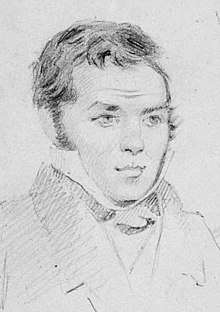Matthew Brady
| Matthew Brady | |
|---|---|
 | |
| Born |
1799 Manchester, England |
| Died |
4 May 1826 Hobart, Tasmania |
| Criminal penalty | Hanged |
| Conviction(s) | Murder |
Matthew Brady (1799 – 4 May 1826) was an English-born convict who became a bushranger in Van Diemen's Land (modern-day Tasmania). He was sometimes known as "Gentleman Brady" due to his good treatment and fine manners when robbing his victims.[1][2][3]
Early life
Brady, whose proper name was Bready, was born in Manchester,[4] just about the close of 18th century. His occupation in England was that of a gentleman's servant, probably a groom, as he was an excellent and even a graceful rider, and perfect in his horsemanship.
Convict years
He was tried at Lancaster on 17 April 1820, and received a seven-year sentence of transportation. He arrived in Australia in the convict ship Juliana on 29 December 1820.[5]
He rebelled against the conditions in Sydney and received, over time, a total of 350 lashes in punishment for misdemeanours and attempts to escape.[4] In 1823, he was sent to the new penal settlement at Sarah Island in Macquarie Harbor, which had been established 'for secondary offenders and desperate prisoners'.[4]
On 7 June 1824, Brady was part of a group of fifteen escapees from Sarah Island, who sailed a whaleboat around the south coast to the River Derwent and spent the next two years as bushrangers.[4]
Bushranging
Brady was considered a gentleman, who rarely robbed or insulted women. The military considered him a dangerous bushranger after Brady's gang held up the township of Sorell and captured the local garrison (in which the garrison commander, Lieut. William Gunn was shot in the arm, which was subsequently amputated). On 14 April 1825 Lieut. Governor Arthur posted rewards for the capture of Brady and his gang.
In return, Brady posted a reward of "Twenty gallons of rum" to any person who would deliver Governor Arthur to him.
On 4 March 1826 Brady and his gang of fourteen attacked Mr Dry's homestead at night. It was a new moon so the night was particularly dark. A servant managed to run to town and call alarm. A posse of troopers responded and a gunfight ensued. No one was killed and the bushrangers slipped away into the night. Three days later Brady rode to Tom Kenton's farm and shot him dead. [6] It was a payback for Kenton setting a trap on Brady. Brady was briefly captured but managed to escape and swore revenge. Days later Brady and his gang captured a boat, intending to sail it to the Australian mainland. Due to bad weather crossing Bass Strait, they were forced to turn back.
Capture
After the sailing fiasco, one of his gang members, an ex-convict name Cowan, betrayed him for a pardon. On 28 March 1826, in consequence of private information, Lieutenant Williams of the 57th Regiment, with 14 soldiers and four armed prisoners, made contact with Brady's gang south of Launceston. Both parties fired, and during the ensuing gun battle Brady was wounded in the leg. The bushrangers separated as they fled. Two stragglers were caught by local farmers.
Brady and four others made it as far as Watery Plains (15 miles south-east of Launceston). On the Saturday night (1 April) a campfire was spotted and John Batman and party went to investigate. The outlaws all fled into the bush, abandoning their fire. Batman and his crew stayed near the campfire. During the night Batman heard a noise and went out to investigate. He saw a man limping in the bush near a shallow creek, and hastened forward to him. It was Brady. Batman induced Brady to surrender and return with him. The outlaw was ill and suffering much pain, and did as he was asked.
On Sunday morning Batman delivered Brady to the Launceston gaol. News quickly spread that Brady was caught, and the townsfolk turned out to see the captured felon pass by on horseback.
Sentencing
On Thursday 27 April 1826, Brady and Patrick Bryant pleaded guilty to the murder with malice of Thomas Kenton. The same two also pleaded guilty of stealing four horses from Mr. Lawrence.[7]
Brady was duly sentenced to death.[8]
Death
Brady was hanged on 4 May 1826, at the old Hobart gaol. Four other bushrangers were hanged with him: Patrick Bryant, John Perry, John Thompson and Thomas Jeffries the cannibal. Brady complained bitterly at being hanged alongside Jeffries, who was, as Brady pointed out, an informer as well as a cannibal and mass murderer. Brady's cell had been filled with flowers from the ladies of Hobart Town, which tends to support his claim to be a "Gentleman Bushranger".
References
- ↑ ""GENTLEMAN BRADY"". The Queensland Times. National Library of Australia. 26 February 1932. p. 5 Edition: DAILY. Retrieved 19 November 2014.
- ↑ "HERALD MAGAZINE SECTION". The Sydney Morning Herald. National Library of Australia. 17 April 1954. p. 9. Retrieved 19 November 2014.
- ↑ "THE AUSTRALIAN-BOOKMAN". The Daily News. Perth: National Library of Australia. 27 August 1932. p. 14 Edition: FINAL SPORTING EDITION. Retrieved 19 November 2014.
- 1 2 3 4 Robson, L.L. (1966). "Brady, Matthew (1799–1826)". Australian Dictionary of Biography. Canberra: Australian National University. Retrieved 5 December 2013.
- ↑ "TASMANIAN HISTORY". The Mercury. Hobart, Tas.: National Library of Australia. 16 August 1873. p. 3. Retrieved 15 April 2012.
- ↑ https://trove.nla.gov.au/newspaper/article/2447371?searchTerm=Thomas%20kenton&searchLimits=l-decade=182
- ↑ https://trove.nla.gov.au/newspaper/article/8790487?searchTerm=mark%20jefferies&searchLimits=l-decade=182
- ↑ "LIFE OF BUSHRANGER POWER". Western Mail. National Library of Australia. 12 February 1910. p. 43. Retrieved 15 April 2012.
- Tom Prior, Bill Wannan, and Harry Nunn (1968). A Pictorial History of Bushrangers. Melbourne: Paul Hamlyn.
External links
- Sketch of Matthew Brady at LINC Tasmania